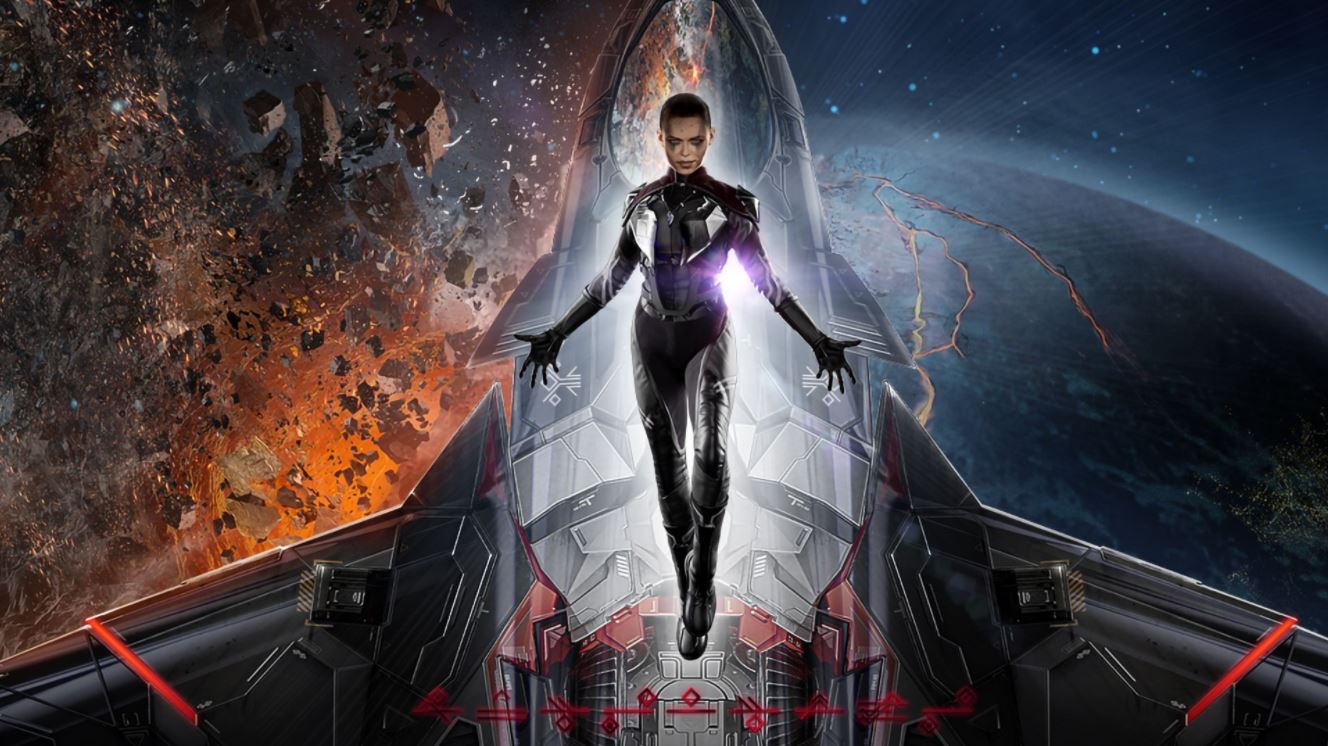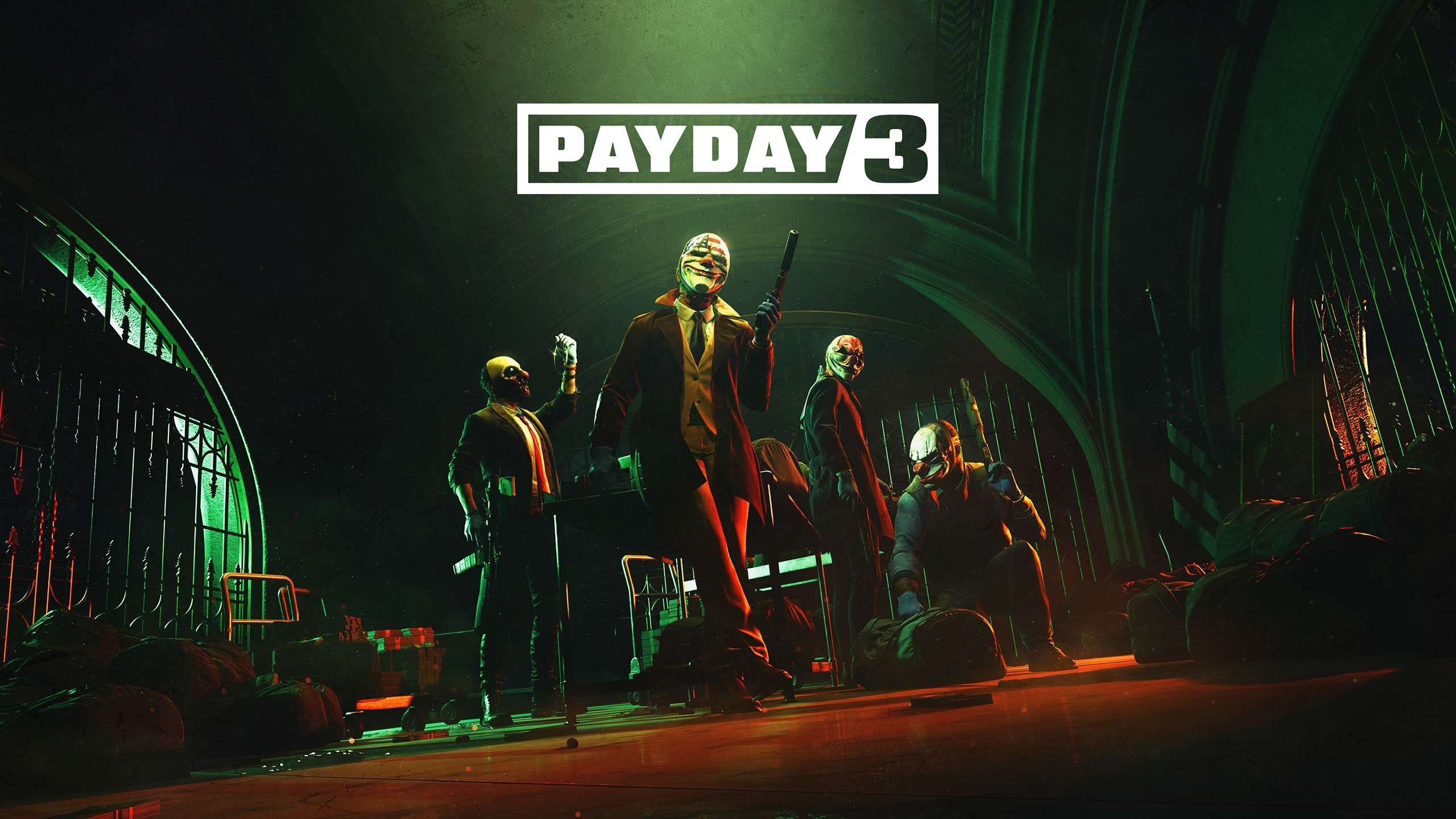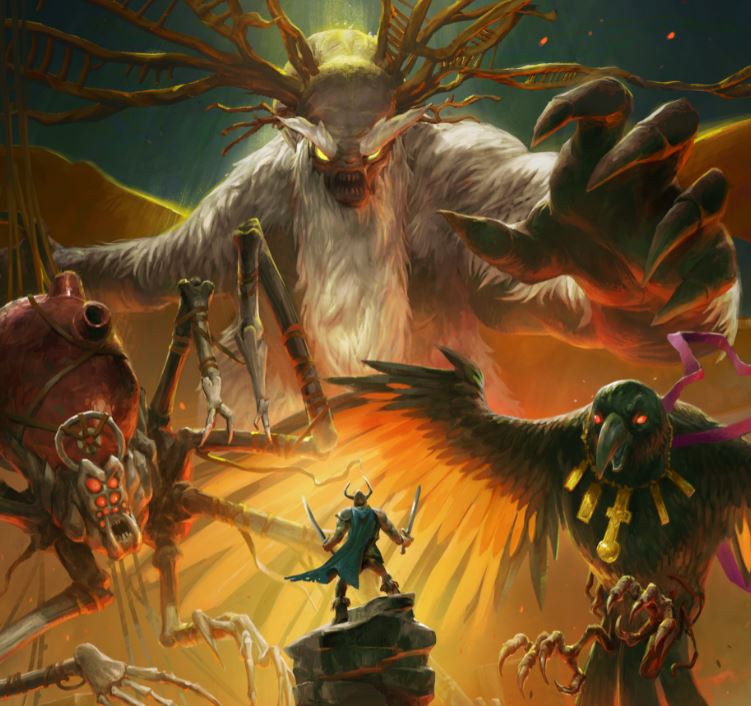Chorus Review (PS5) – When The Lead Singer Goes Solo
Action-packed space flight sim Chorus launches into the vacuum. But is it soaring to success, or plummeting into a black hole? The Finger Guns Review.
Chorus tries to do something a little different from your average space flight sim; it wants to tell a story. From beginning to end, this arcadey space sim eschews the dull mission structure and lack of meaningful context of many of its contemporaries and opts for open-world hubs, constant dialogue with other ships and your onboard AI, and a detailed and heavy narrative that often takes too much focus from the gameplay.
If you like truly hard-science space simulators this won’t be for you; Chorus is a responsive delight to play when it gets out of its own way, but it is an arcade sim with forgiving and simple controls. It’s also not that wide in scope – there’s no multiplayer, trading, or Eve-style factions or wars. Chorus is a tight single-player experience staged over three fairly short acts, that can be padded out a little with side missions. Where it shines is its combat which could give even the greats like Rogue Squadron a run for their money.
So let’s take a look in the engines and see what makes this game go.
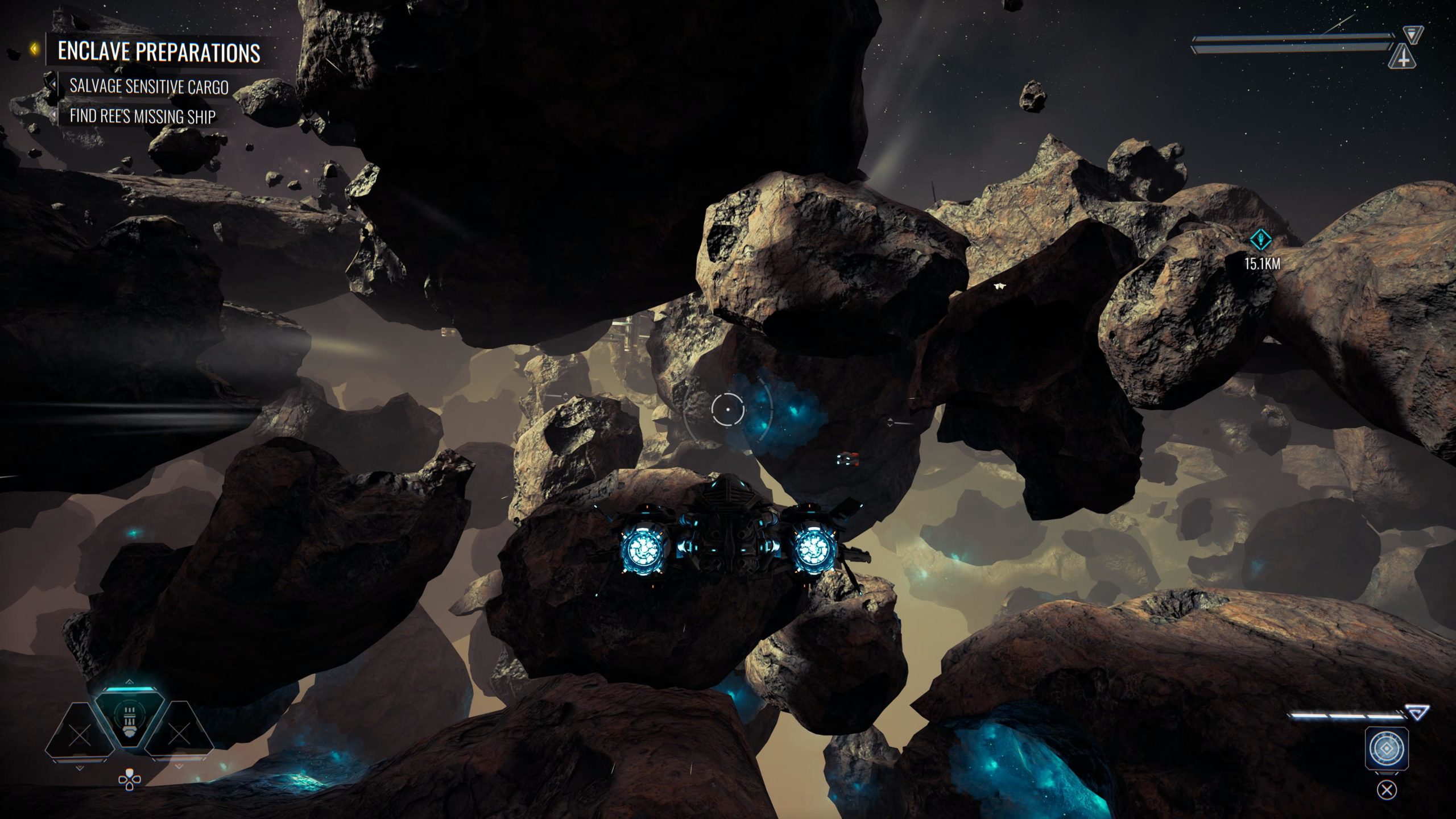
Starting almost at the end of another entire story, Chorus stars Nara as a veteran fighter pilot, once loyal in faith to the mighty Circle doctrine. Circle is the aligning belief system of most of the galaxy, presided over by the Prophet, a sci-fi Dalai Lama able to unlock the supernatural gifts of his loyal servants. As religious leader of the galaxy, you just know he’s a baddun. His believers slide the word ‘Chorus’ into every sentence they can – something about all systems being aligned together in a great song.
The Circle once taught a message that Nara believed in, and she worked tirelessly as the Prophet’s executioner to bring worlds into line with the great Chorus. Until she didn’t. Faced with Tarkin-esque orders to destroy a planet, she carried out said orders, and it broke her faith. Racked with guilt, she fled, joined remnants of a ragtag dissident group (trying not to write Rebel alliance there) aiming to bring down what had become a religious cult Empire. See, I told you – that’s enough for another whole game right there, and that’s just the prologue.
After a short time getting to know the flight controls and doing a few odd job missions, it’s time to reawaken your Circle ship, a sentient AI fighter, and then relearn the skills you lost leaving the Chorus behind. Nara is now on a mission to destroy the Circle and its Prophet before they can subjugate and destroy any other worlds.
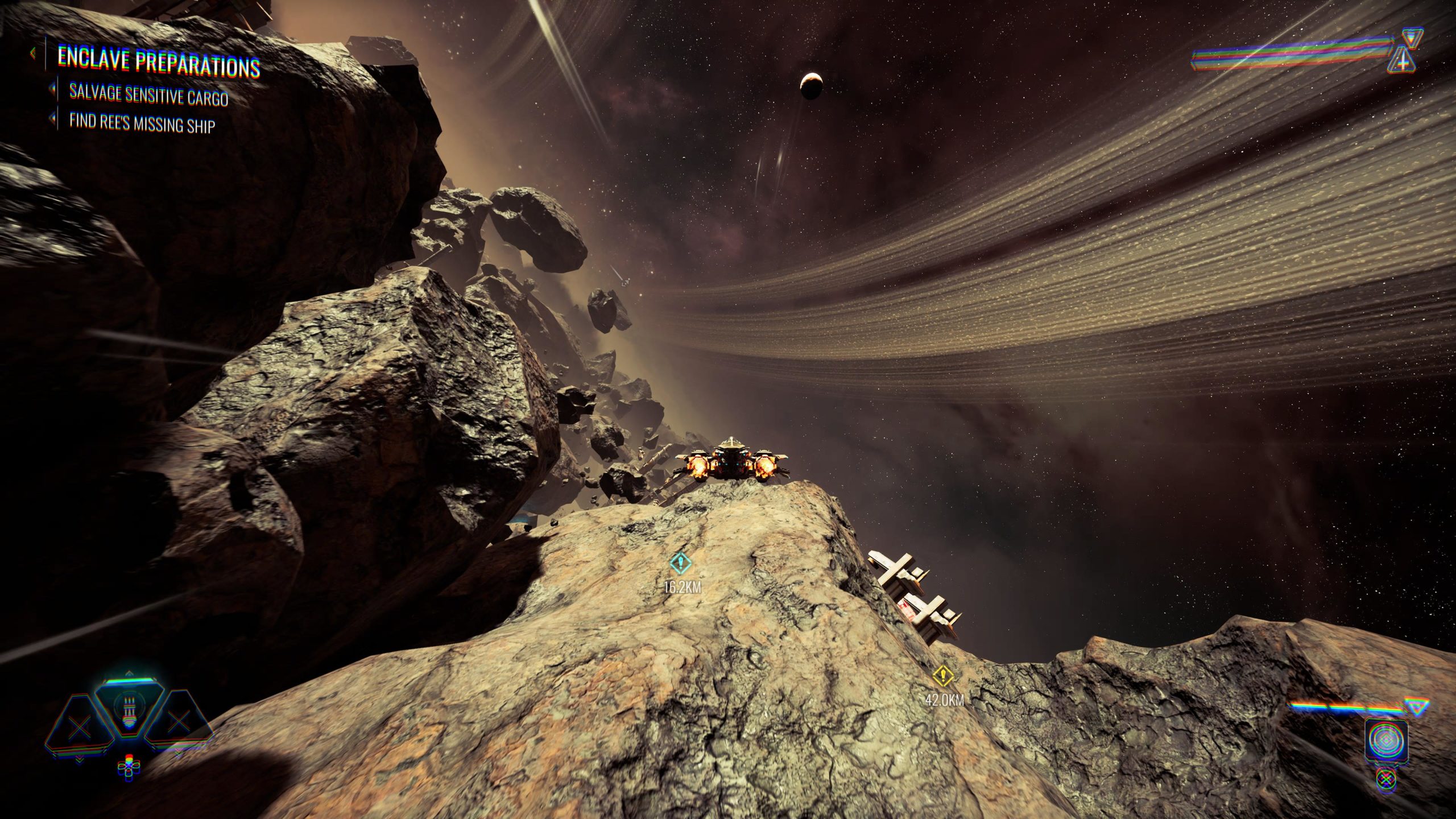
It’s a great setup, but there are issues with the narrative that bugged me throughout. Nara battles a sort of constant whispering internal monologue with herself; one side is the original who did terrible things for the cult, the other is the newer Nara wishing to redeem herself. Sounds good on paper, but comes across as a confusing cliché-ridden morass of existential navel-gazing. I’m not a fan of multiple personalities and the ways filmmakers and video game developers generally employ the trope. There’s enough with her talking to her sentient ship without the extra versions of herself.
As you fly between supply missions to bring the resistance up to a standard they can face the Circle, you spend just as much time battling Nara’s inner demons. You’ll encounter countless memories that play out as audio bites over a tableau of ship destruction, and as the game progresses these get more and more religious and esoteric. Add to that the manifestations of Nara’s guilt chasing you through asteroid tunnels whenever you try to unearth new Rift skills, and it all gets a bit much. There’s enough in the story without this strange and heavy internal character development done through physical missions.
I wish instead that there had just been a few scenes where Nara could reveal more about herself, emotional scenes with those she cares about for example. Nara is untethered to any human contact, family or real friendships – only the Prophet looms large in her mind and everyone else is a fairweather comrade. This focuses her story, but it means there’s little opportunity for more effective character development through relationships.
On the surface, Chorus’ narrative should work, but with Nara being a difficult character to invest in, the heavy subject matter, confusing memories and manifested emotions, it all becomes a little too much to coherently hang onto.
Let’s move on to something I really did like. The combat.
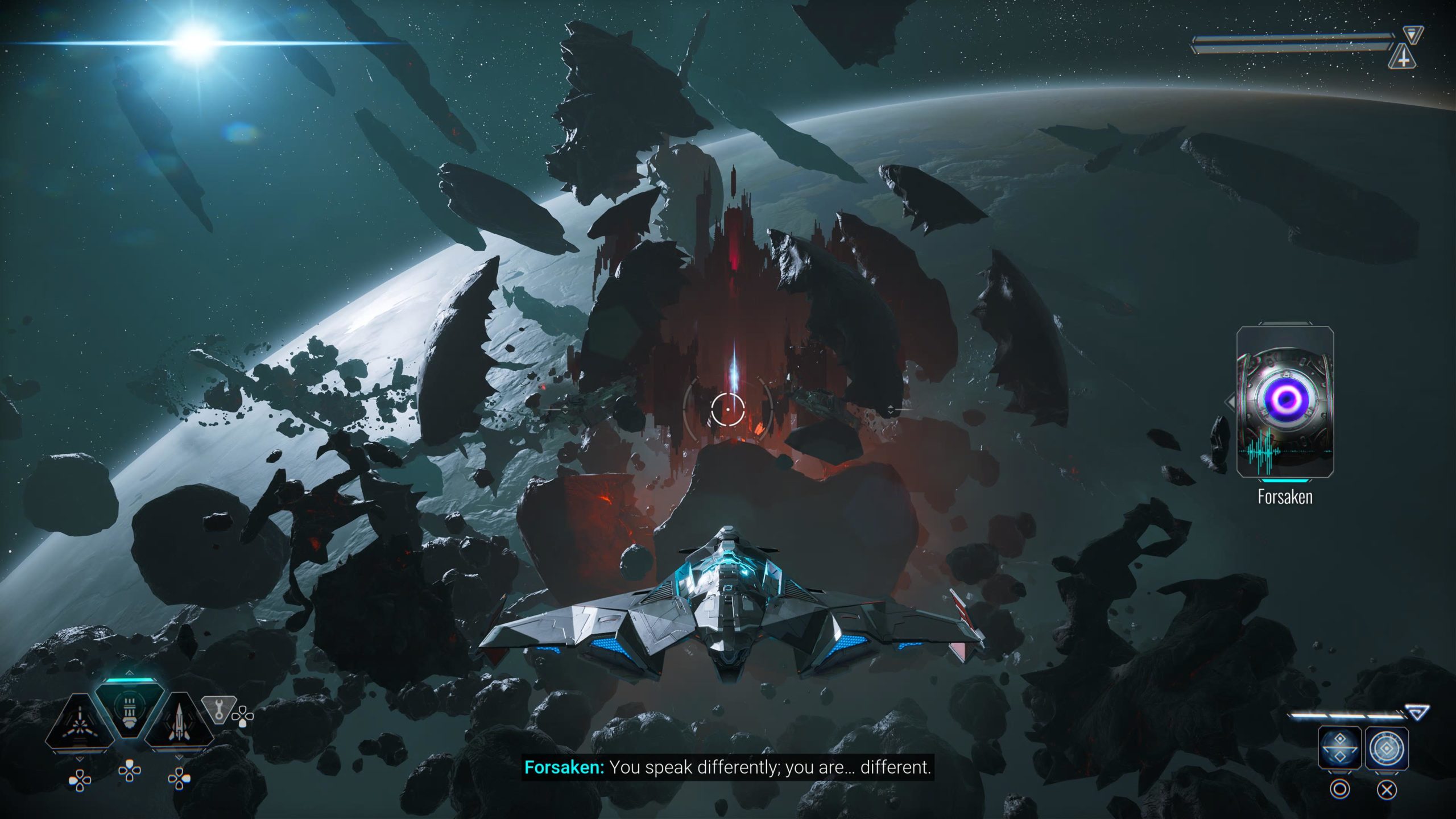
Flying in Chorus is intuitive and simple, mainly because of the hyper-responsive controls on the PS5, nifty vacuum brakes and smart acceleration control tied to forward and back. You can accelerate and decelerate with speed and control that you don’t always find in flight sims. All direction-based flight is controlled through the right analog stick and the left is dedicated to simple dodging barrel rolls, instead of one being direction and the other tilt. You also have a boost command, and a hyperdrive, which you need to traverse the vast expanses of the game’s overworld hubs with speed.
Combat is something that I find makes or breaks most space sims – are you forever trying to circle round yourself chasing the tails of gnat-like enemy fighters? This can be frustrating and off-putting. Chorus manages to minimise this by generally having both AI that sweeps outward further before changing directions and targeting you, and also by making its accuracy quite forgiving. The hitbox is a manageable size, at least encompassing the whole of the enemy fighter and probably its shield – this makes for combat that is fast and furious, but also satisfying and unfrustratingly structured.
Levels that seem small on the horizon of an asteroid field, grow to become exciting three-dimensional obstacles. We’re talking huge space stations, mining facilities, and fortresses. Ships that dwarf your tiny fighter, and are so massive you can fly through their internals blasting fuel cells and shield generators off the walls. Flying through the insides of ships and asteroids is a definite highlight that I never grew tired of.
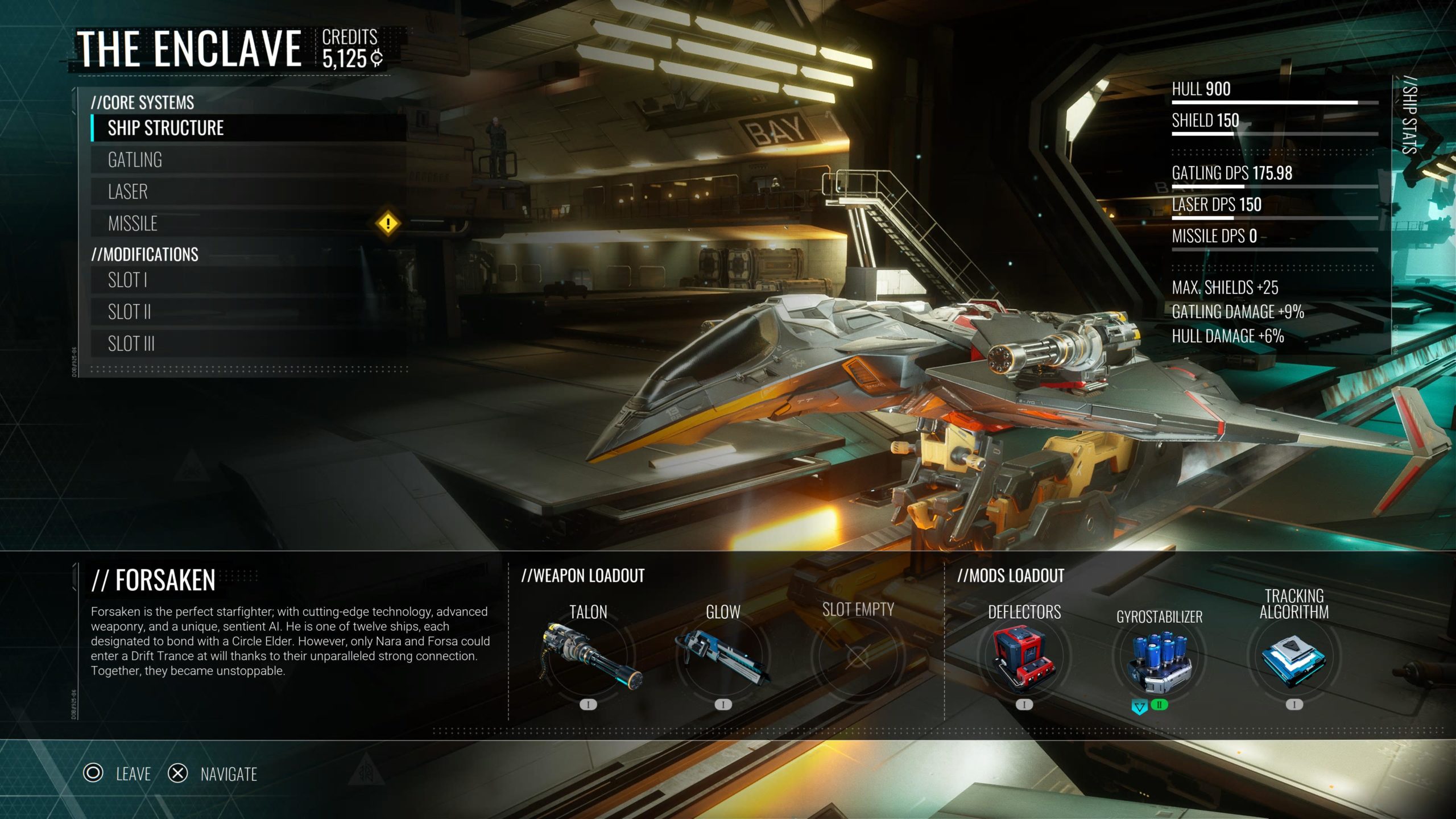
Enemy ship design is also something that keeps you on your booster button. Drip-fed throughout the campaign enemies get progressively more interesting and tricky to fight; what may start as easy Gatling-fodder, soon needs a shield taken out first, or has a constant shield requiring the use of your Rift skills to jump behind an enemy and blast them before they can flip their shields. In act two the Faceless enemies are incredibly nimble and lock-on to the back of your ship, but have almost no health. There are mine layers, peppering space with floating death and ships that dart away from you only to wait until the moment you chase them before blasting out an engine-frying net. I had tons of fun with the different enemy types and the combinations of ways you can employ your skills and weapons to great effect.
This was until around the beginning of Act 3 where the difficulty spiked somewhat and a Sentinel mini-boss derailed my campaign for a few hours. This enemy could laser you from anywhere, turned its weak points away from you constantly, and the area was filled with other fighters so I could hardly use the jump behind trick without jumping completely off target. Sentinels, man. Overall the game is on the moderate side, but apart from a couple of moments it shouldn’t prove a problem to most.
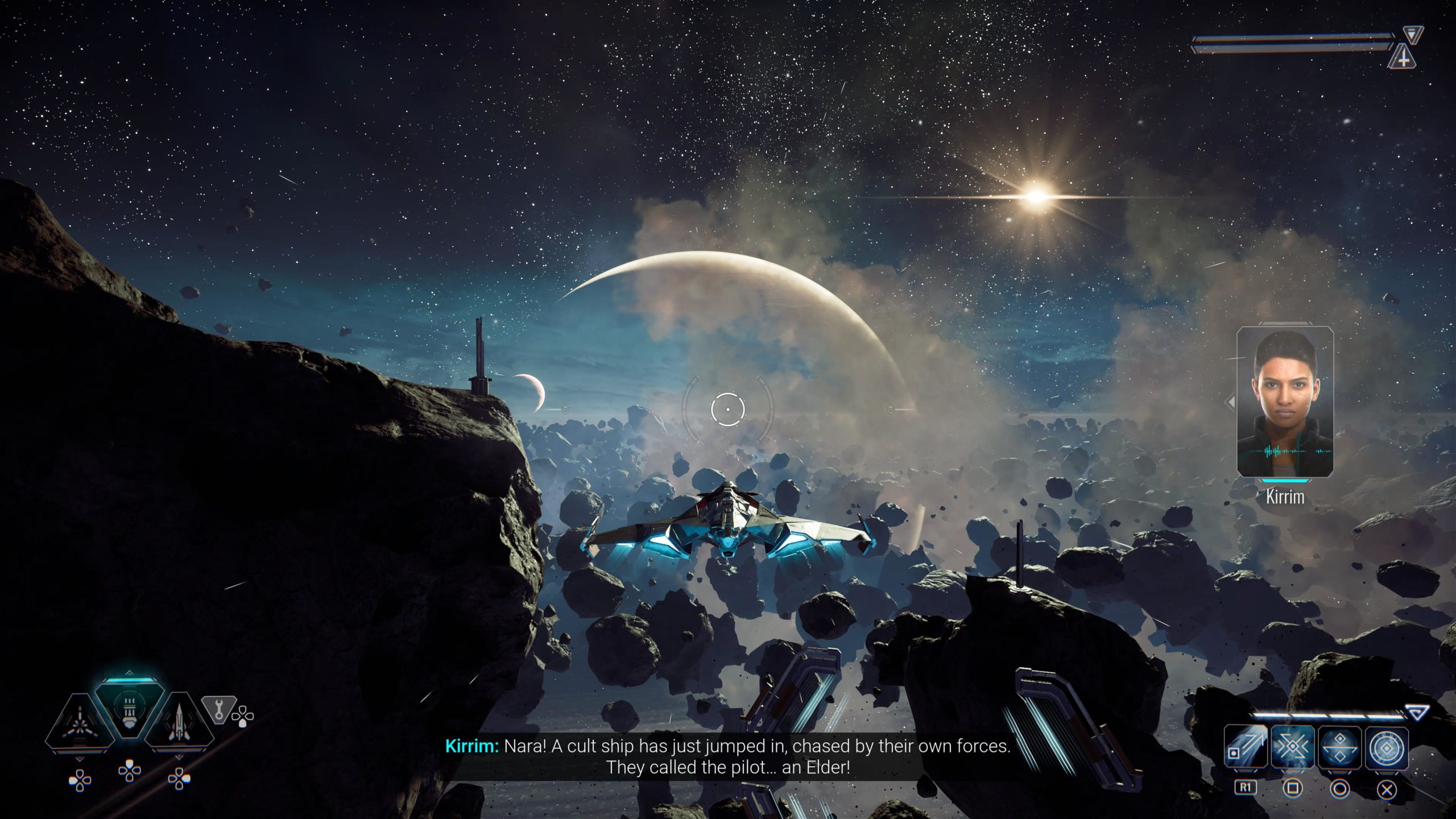
Each hub has a hangar where you can land and buy a few bits for your talking ship. You have your hull strength, shield integrity and such, but the more beneficial upgrading comes from experience. Chorus employs a do-it-lots-and-it-gets-stronger mentality; shoot and your gatling guns get stronger, boost-kill and your boosts get faster, use a disruptor and your disruptor gets better. Each measure has five levels to Mastery and it’s a good system, rewarding you for playing the game, and strengthening the systems you use the most. It means you automatically upgrade towards the build that most suits your play style.
The downside is that if you never use Drift, one of the systems I found counterintuitive to perform, then you’ll never get any upgrades or enhancements for Drifting. It’ll soon be something that you leave far behind, because it’s no longer powerful enough to bother with.
Lastly for combat, a handful of missions have you dock your fighter into a larger, and far more cumbersome warcraft. I liked to think of it as a space tank. You are gifted incredible firepower, enough to rip to shreds any and everything that comes close, but you trade off in maneuverability. Thrust is set to L2 but the thing moves like a drunk snail. The control scheme changes; no longer does forward and back give you boost and speed, now it tips the Y-axis, making you tumble slowly forward or back. Thankfully these sections are few and far between as for me they didn’t really work.
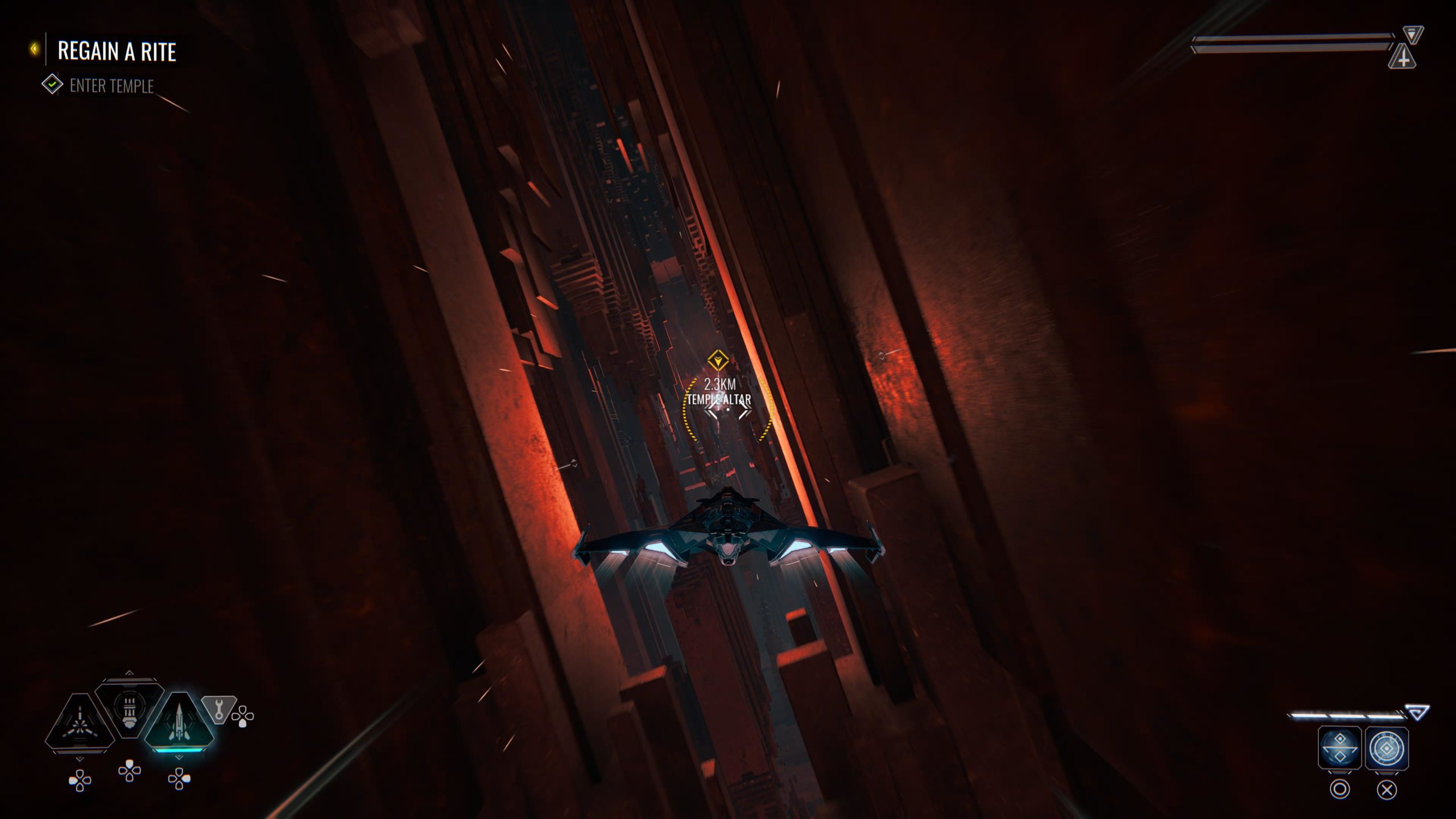
Chorus’ graphics shine on PS5. The game feels remarkably polished; two seconds loading time from the title screen and suddenly vistas of beautiful space scenes are constantly unfolding in the background of your dogfights. Planetary coronas hang in the darkness, stars light the asteroids, shadows bounce off every contour. Just take a look at these screenshots.
The graphics also never took a dip that I could see, remaining clean and smooth throughout my playtime. Your ship Forsa, is a beautiful thing to behold, let alone fly. Crisp lines, and lots of articulated sections that move and elongate as you boost or brake makes for a satisfying flight. For an AA title, we’re dealing with graphics a AAA flight sim would be jealous of.
The same can’t quite be said of the cutscenes and human-scale sections that happen in the cockpit or in Nara’s shattered and broken mind. She’s an interesting character design, but her facial animations betray the games’ budget, looking ungainly. As I grew disinterested in the story, so too did I grow to dread the sections where she would battle whatever Faceless had embodied her demons most recently.
On the sound side of things, Chorus does have a few dissonant and evocative tracks, that enhance the atmospheric parts. When you are deep inside a space temple, it’s good to have that foreboding drone, but overall I found in many places the soundtrack slipped into unremarkable territory, fading to black.
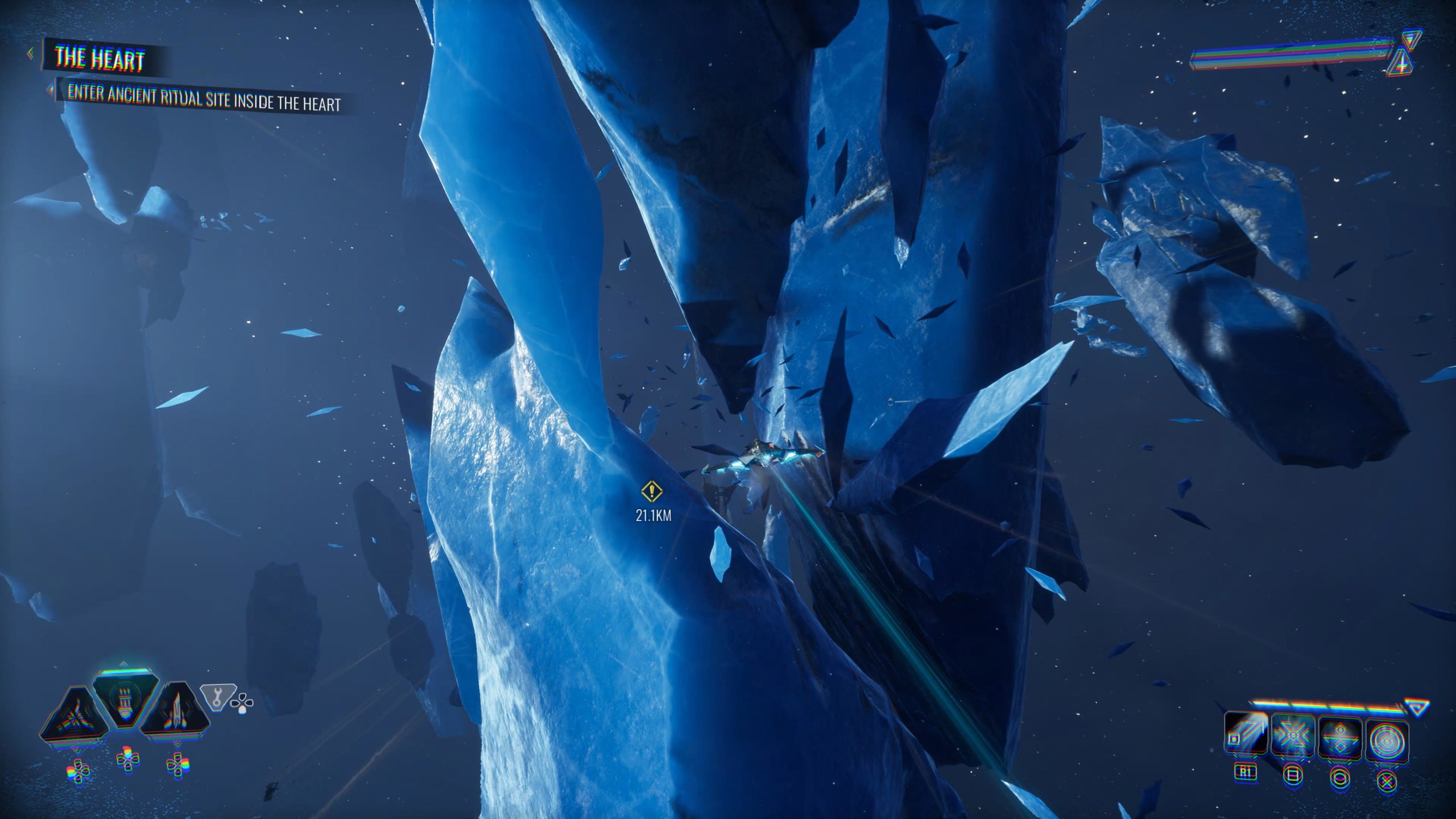
I hate to say this, because I love a good story, but Chorus is at its best when it gets out of its own way; leaving the religious cult and mental manifestation stuff behind and purely letting you fly a gloriously responsive ship through a beautiful sci-fi setting. When it’s just you and your sentient ship flying rings around your enemies is when you feel most alive.
Then it gets itself far too bogged down in what is a pretty dull story, told in a way that emphasises all the most unrelatable stuff. Nara is hard enough to bond with – she ends an entire civilisation in the first 5 minutes – without having to trudge through her guilt manifested as alien ships trying to kill you, without constant memories of completely unnoteworthy events and religious dogma dialogue. Hard sci-fi often fails because it de-emphasises character, and characters are what draw you into a story. Nara is a hard character to like, let alone sympathise with.
It would have been enhanced by having the Prophet be more present in the story; an antagonising force that you can rally against, or even rally behind Nara in the face of his atrocities. The only real atrocity you see is Nara’s, and the Prophet was just the faceless man who ordered it. The rest of the game is spent telling you that he’s terrible and that he’ll end the universe, but never showing you something terrible he’s done, or making it a remotely emotional mission. I’m all for ending cults, just because we should end cults, but in the service of story, Chorus missed a lot of tricks.
If you are looking for a space shooter after Squadrons, then the actual flying is dope, the missions are fun and the overworld hub is a feature I’d like to see in more flight sims. It’s worth your time investment, as you can get through the main campaign in around 10 hours without too much trouble. Just don’t expect to get heavily invested in a story that’ll probably leave you cold as the vacuum of space.
Chorus shines in its exceptionally fun flight chops and smooth handling. Dogfighting in space never felt so responsive or satisfying and the backdrops can be stunning. However its ambitious, heavy story and unsympathetic heroine will leave some cold, some confused, and others simply bored.

Chorus is out now on PlayStation 4, PlayStation 5 (review platform), Xbox One, Xbox Series S|X and PC.
Developer: Fishlabs
Publisher: Deep Silver
Disclaimer: In order to complete this review, we were provided with a promotional copy of the game. For our full review policy, please go here.
If you enjoyed this article or any more of our content, please consider our Patreon.
Make sure to follow Finger Guns on our social channels –Twitter, Facebook, Twitch, Spotify or Apple Podcasts – to keep up to date on our news, reviews and features.
